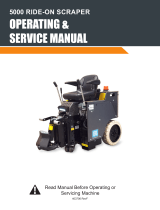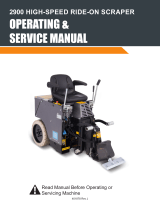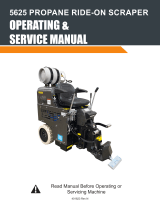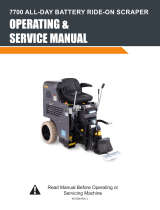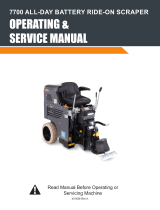
Table of Contents
3
Table of Contents .......................................................................................................................................................... 3
Features and Specicatons .......................................................................................................................................... 4
Safety .............................................................................................................................................................................. 6
General Rules for Safe Operation ......................................................................................................................... 6
Walk-Behind Scraper Safety Guidelines ................................................................................................................ 7
Hydraulic Safety Tips ............................................................................................................................................. 8
Components and Assembly ......................................................................................................................................... 9
Transportation ........................................................................................................................................................ 9
Wheel Modes ......................................................................................................................................................... 9
Application Setup ................................................................................................................................................. 10
Adding/Removing Side Slide Weights ................................................................................................................. 10
Operation .......................................................................................................................................................................11
Operating Controls ................................................................................................................................................11
Start-Up Procedure ...............................................................................................................................................11
Preparing Blades ..................................................................................................................................................11
Troubleshooting Guide ............................................................................................................................................... 13
Warranty ....................................................................................................................................................................... 14

Features and Specications
4
FEATURES
Product Specications
Width
Length
(Handle
Folded)
Height Weight Speed RPM HP Amps
(full load)
Vibration
X Axis Y Axis Z Axis
17.75”
(451 mm)
29”
(736.6 mm)
46” (1,168 mm)
(max. height)
30” (762 mm)
(handle folded)
334 lbs (151.5 kg)
(machine only)
424 lbs (192.3 kg)
(with weights)
10-45 ft/min
(USA only)
0-20 m/min
3450 1.5 13 3.2
m/s2
6.3
m/s2
4.8
m/s2
Speed Control Dial - Limits maximum forward speed.
Kickstand - Aids operator in tilting the machine back for easier mov-
ing and maneuvering.
Traction Wheels - Self-cleaning industrial-grade wheels that disen-
gage for loading/unloading.
Side Slide Weights with Quick-Adjust Levers - Slides over wheels
and applies additional pressure to the scraper head if more traction is
needed.
Control Handle Levers - Controls both speed and direction of
scraper with simple twist grips.
Lifting Bail Eyebolts - Eases loading/unloading.
Debris-Deecting Front Weight - Prohibits material and debris from
obstructing production.
Quick-Adjust Multi-Position Handle - Folds at over machine for
storage or transport; allows adjustment of handle angle to suit opera-
tor or work conditions.
Speed Control Dial
Kickstand
Traction Wheels
Control Handle Levers
Lifting Bail Eyebolts
Debris-Deecting
Front Weight
Slide Weights
Quick-Adjust
Multi-Position Handle

Features and Specications
555
Machine Variants
Region Serial Number Input Power Body Panels
Domestic
6280-COM-10XXXX 120V / 60 Hz Silver Vein
6280-COM-12XXXX 120V / 60 Hz Green
6280-COM-23XXXX 120V / 60 Hz Silver Vein
International
6280-COM-11XXXX 230V / 50 Hz Silver Vein
6280-COM-13XXXX 230V / 50 Hz Silver Vein
6280-COM-15XXXX 230V / 50 Hz Orange
6280-COM-20XXXX 110V / 50 Hz Silver Vein
6280-COM-26XXXX 230V / 50 Hz Silver Vein
6280-COM-28XXXX 100V / 50/60 Hz Silver Vein

Safety
Environment
Avoid use in dangerous environments.
Do not use in rain, damp or wet locations, or in the presence of
explosive atmospheres (gaseous fumes, dust, or ammable mate-
rials). Remove materials or debris that may be ignited by sparks.
Keep work area tidy and well-lit - a cluttered or dark work area may
lead to accidents. Extreme heat or cold may affect performance.
Protect others in the work area and be aware of surroundings.
Provide barriers or shields as needed to protect others from debris
and machine operation. Children and other bystanders should be
kept at a safe distance from the work area to avoid distracting the
operator and/or coming into contact with the machine. Operator
should be aware of who is around them and their proximity. Sup-
port personnel should never stand next to, in front of, or behind
the machine while the machine is running. Operator should look
behind them before backing up.
Do not come within 3 ft. of the machine’s perimeter during
operation.
Guard against electric shock.
Ensure that machine is connected to a properly grounded outlet.
Prevent bodily contact with grounded surfaces, e.g. pipes, radia-
tors, ranges, and refrigerators. When scoring or making cuts,
always check the work area for hidden wires or pipes.
6
GENERAL RULES FOR SAFE OPERATION
Before use, anyone operating or performing maintenance on this equipment must read and understand this manual, as well as any labels pack-
aged with or attached to the machine and its components. Read the manual carefully to learn equipment applications and limitations, as well
as potential hazards associated with this type of equipment. Keep manual near machine at all times. If your manual is lost or damaged, contact
National Flooring Equipment (NFE) for a replacement.
Personal
Dress properly and use safety gear.
Do not wear loose clothing; it may be caught in moving parts.
Anyone in the work area must wear safety goggles or glasses and
hearing protection. Wear a dust mask for dusty operations. Hard
hats, face shields, safety shoes, etc. should be worn when speci-
ed or necessary.
Maintain control; stay alert.
Keep proper footing and balance, and maintain a rm grip. Ob-
serve surroundings at all times. Do not use when tired, distracted,
or under the inuence of drugs, alcohol, or any medication that
may cause decreased control.
Keep hands away from all moving parts and tooling.
Wear gloves when changing tooling. Remove tooling when ma-
chine is not in use and/or lower cutting head to the oor.
Do not force equipment.
Equipment will perform best at the rate for which it was designed.
Excessive force only causes operator fatigue, increased wear, and
reduced control.
Equipment
Use proper parts and accessories.
Only use NFE-approved or recommended parts and accessories.
Using any that are not recommended may be hazardous.
Ensure accessories are properly installed and maintained.
Do not permanently remove a guard or other safety device when
installing an accessory or attachment.
Inspect for damaged parts.
Check for misalignment, binding of moving parts, loose fasteners,
improper mounting, broken parts, and any other conditions that
may affect operation. If abnormal noise or vibration occurs, turn
the machine off immediately. Do not use damaged equipment until
repaired. Do not use if power switch does not turn machine on and
off. For all repairs, insist on only identical NFE replacement parts.
Maintain equipment and labels.
Keep handles dry, clean, and free from oil and grease. Keep cut-
ting edges sharp and clean. Follow instructions for lubricating and
changing accessories. Motor and switches should be completely
enclosed at all times with no exposed wiring. Inspect cord regu-
larly. Labels carry important information; if unreadable or missing,
contact NFE for a free replacement.
Avoid accidental starting; store idle equipment.
When not in use, ensure that the machine is unplugged; do not
turn on before plugging in. Store in a dry, secured place. Remove
tooling when storing, and keep away from children.
Maintenance & Repairs
Begin maintenance work only when the machine is shut
down, unplugged, and cooled down.
Use proper cleaning agents.
Ensure that all cleaning rags are ber-free; do not use any aggres-
sive cleaning products.
Schedule regular maintenance check-ups.
Ensure machine is properly cleaned and serviced. Remove all
traces of oil, combustible fuel, or cleaning uids from the machine
and its connections and ttings. Retighten all loose ttings found
during maintenance and repair work. Loose or damaged parts
should be replaced immediately; use only NFE parts.
Do not weld or ame-cut on the machine during repairs, or
make changes to machine without authorization from NFE.
CAUTION! ENSURE PROPER USE OF EXTENSION CORDS. IF AMP DRAW IS HIGHER THAN SHOWN
ON TABLE OR CORD IS LONGER THAN 50 FT, SEE AN ELECTRICIAN.
ASSUMPTIONS: 3% ALLOWABLE VOLTAGE DROP, COPPER CONDUCTORS RATED FOR 75OC, 1.25
SAFETY FACTOR, CORD VOLTAGE RATING OF 600VAC, PROPER CORD TYPES (STO, STOW, SOOW).
Amp Draw Gauge
0-12 14
13-16 12
14-24 10
25-40 8

WALK-BEHIND SCRAPER SAFETY GUIDELINES
Before use, anyone operating this equipment must read and understand these safety instructions.
7
WARNING: GRINDING/CUTTING/DRILLING OF MASONRY, CONCRETE, METAL AND OTHER MATERIALS CAN GENERATE DUST,
MISTS AND FUMES CONTAINING CHEMICALS KNOWN TO CAUSE SERIOUS FATAL INJURY OR ILLNESS, SUCH AS RESPIRATORY
DISEASE, CANCER, BIRTH DEFECTS OR OTHER REPRODUCTIVE HARM. IF YOU ARE UNFAMILIAR WITH THE RISKS ASSOCIATED
WITH THE PARTICULAR MATERIAL BEING CUT, REVIEW THE MATERIAL SAFETY DATA SHEET AND/OR CONSULT YOU EMPLOYER,
THE MATERIAL MANUFACTURER/SUPPLIER, GOVERNMENTAL AGENCIES SUCH AS OSHA AND NIOSH AND OTHER
AUTHORITIES ON HAZARDOUS MATERIALS. CALIFORNIA AND SOME OTHER AUTHORITIES, FOR INSTANCE, HAVE
PUBLISHED LISTS OF SUBSTANCES KNOWN TO CAUSE CANCER, REPRODUCTIVE TOXICITY, OR OTHER HARMFUL
EFFECTS. CONTROL DUST, MIST AND FUMES AT THE SOURCE WHERE POSSIBLE. IN THIS REGARD USE GOOD
WORK PRACTICES AND FOLLOW THE RECOMMENDATIONS OF THE MANUFACTURER/SUPPLIER, OSHA/NIOSH,
AND OCCUPATIONAL AND TRADE ASSOCIATIONS. WHEN THE HAZARDS FROM INHALATION OF DUST, MISTS AND
FUMES CANNOT BE ELIMINATED, THE OPERATOR AND ANY BYSTANDERS SHOULD ALWAYS WEAR A RESPIRATOR
APPROVED BY OSHA/MSHA FOR THE MATERIAL BEING CUT.
Scraping
Beware of hidden obtrusions.
Watch out for hidden dangers and protrusions in ooring. Do not
use on largely uneven surfaces.
Observe location of electrical supplies and extension cords.
Do not allow cutting heads to come into contact with any electrical
supply or extension cord.
Use correct tooling and accessories.
Provide barriers or shields as needed to protect others from debris.
After mounting tooling, check for proper alignment.
Use for correct applications.
Do not force equipment to do heavier duty work than it was made
for.
Safety

Safety
8
HYDRAULIC SAFETY
Maintaining a Safe Work Environment
Establishing a safe work environment in and around your hydraulic equipment is extremely important. The easiest and most effective way to
avoid problems is to make sure associates understand their equipment, know how to operate the machines safely, and recognize the dangers if
handled carelessly. A few things to be aware of are:
• Pressure: Hydraulic uid under pressure is dangerous and can cause serious injury. Never look for a leak when unit is under pressure.
Using your hand could cause serious injury. A few common ways to encounter hydraulic uid under pressure include:
▪ Pinhole: Fluid under pressure can cause serious injury. It can be almost invisible escaping from a pinhole, and it can pierce the skin
into the body.
▪ Leak: Keep ttings and hoses tight. Only check and service when not under pressure. Leaking hydraulic uid is hazardous; in addition
to making workplace oors slippery and dangerous, it also contaminates the environment. Before cleaning an oil spill, always check
EPA, state, and local regulations.
▪ Burst: Whether due to improper selection or damage, a ruptured hose can cause injury. If it bursts, a worker can be burned, cut,
injected, or may slip and fall.
▪ Coupling Blow-Off: If the assembly is not properly made or installed, the coupling could come off and hit or spray a worker, possibly
resulting in serious injury. Never operate machine without guards.
• Flammability: When ignited, some hydraulic uids can cause res and/or explode.With the exception of those comprised primarily of
water, all hydraulic uid is ammable (including many “re-resistant” hydraulic uids) when exposed to the proper conditions. Leaking pres-
surized hydraulic uids may develop a mist or ne spray that can ash or explode upon contact with a source of ignition. These explosions
can be very severe and could result in serious injury or death. Precautions should be taken to eliminate all ignition sources from contact
with escaping uids, sprays or mists resulting from hydraulic failures. Sources of ignition could be electrical discharges (sparks), open
ames, extremely high temperatures, sparks caused by metal -to -metal contact, etc.
• Mechanical: Hydraulic uid creates movement, which means some equipment may move. Observe surroundings and equipment at all
times.
• Moisture: Do not use in wet or high moisture conditions.
• Electrical: Faulty wiring can be an electrical hazard. A regular preventive maintenance program should always include a wiring check. If
applicable, disconnect battery before serving.
• Temperature: Because this machine operates at a relatively low pressure, overheating is not common. If surface of tank becomes too hot
to touch by hand (above 130ºF or 55°C), shut off machine and allow it to cool.
Hydraulic Fluid
Only use Texaco Rando 46 Hydraulic Oil or compatible uid like ISO or AW #46 from a brand name manufacturer. Non-compatible uids could
cause damage to unit or serious injury.
CAUTION: NEVER USE YOUR HANDS TO CHECK FOR LEAKS OVER HOSE OR HYDRAULIC CONNECTIONS. USE A PIECE OF CARD-
BOARD TO LOCATE A PRESSURIZED LEAK. FOR LOW PRESSURE LEAKS (DRIPS), USE A RAG TO CLEAN THE AREA AND DETERMINE
WHERE THE LEAK ORIGINATES.
DANGER: DO NOT TOUCH A PRESSURIZED HYDRAULIC HOSE ASSEMBLY WITH ANY PART OF THE BODY. IF FLUID PUNCTURES
THE SKIN, EVEN IF NO PAIN IS FELT, A SERIOUS EMERGENCY EXISTS. OBTAIN MEDICAL ASSISTANCE IMMEDIATELY. FAILURE TO DO
SO COULD RESULT IN LOSS OF THE INJURED BODY PART OR DEATH.

Components and Assembly
9
TRANSPORTATION
Attach/Remove Transport Wheels
Transport wheels help eliminate damage to the ooring and make moving the machine
easier. To attach transport wheels, complete the following steps:
1. Remove two outside blade cover bolts (Figure 1).
2. To ensure cutting head has enough clearance for front wheel assembly to t under,
tip machine back and block up the front (Figure 1.1).
3. Mount front wheel assembly over blade cover; re-place two outside blade cover
bolts (Figure 1.2).
4. Remove blocks.
Note: Do not leave machine in transport mode during transit without being secured.
To remove, reverse these steps.
Lifting Bail
The lifting bails make loading/unloading easier when when unable to use a ramp. Loca-
tion of lifting bails centers the balance of the machine, making it safe to pick up machine.
1. Place rope, hook system, or chain through eyelets located on top of machine.
2. Raise machine with a fork lift or winch.
3. Slowly lower to desired location.
Ramp Unloading
1. Put the wheels in “engage mode” (Figure 2).
2. Position ramp securely to back of vehicle; ensure there is good contact.
3. Position machine at the back of the truck, in line with the ramp.
4. Carefully move machine onto ramp, leaving the cutting head down (in contact with
ramp surface). Be cautious; machine is heavy.
5. Slowly back machine down ramp.
WHEEL MODES
Wheels engage and disengage for easier maneuverability. Wheels in the “engage mode”
are secured with axle pins (Figure 2), which engage the wheels so the machine can be
self-propelled.
When wheels are in the “disengage mode” (Figure 2.1), the machine can be moved freely
when not under power.
Disengaging Wheels
1. Lift ring outwards; slide pin up and off.
2. Repeat on second wheel.
Note: Keeping the axle pin facing straight up will make re-engaging easier.
FIG. 1
FIG. 1.1
FIG. 1.2
WARNING: NEVER HAVE TRANSPORT WHEEL ASSEMBLY MOUNTED
ON MACHINE OR WEHEELS DISENGAGED WHEN GOING UP OR DOWN A
LOADING RAMP OR INCLINE. FAILURE TO DO SO COULD CAUSE LOSS OF
CONTROL, DAMAGE TO MACHINE OR PROPERTY, OR SERIOUS INJURY.
CAUTION: REMOVE ALL COUNTER WEIGHTS AND BLADES AND ENSURE
WHEELS ARE IN “ENGAGE MODE” (FIGURE E) BEFORE LOADING OR
UNLOADING. FAILURE TO DO SO COULD RESULT IN PROPERTY DAMAGE
AND/OR PERSONAL INJURY.
FIG. 2
FIG. 2.1

Components and Assembly
Re-engaging Wheels
1. Line up wheel hub hole and axle hole (Figure 3).
2. Insert pin and push ring over the hole so that it is parallel to the wheel.
3. Repeat on second wheel.
APPLICATION SETUP
VCT Tile
Never use a blade wider than the size of the tile being removed. If materials being
removed still do not come up clean or machine jumps on top of materials, reduce blade
size or use a smaller portion of the blade.
Pure Vinyl Rubber Tile
Materials will need to be scored down to 10-12” (25-30.5 cm) for proper removal. Self-
scoring blades can be used with some materials. A 10” blade is recommended for this
application.
Direct-Glued Carpet
Done with either self-scoring blades or by pre-scoring carpet to match the blade width
prior to stripping with a scoring tool. Pre-scored carpet makes machine easier to control
and blades will stay sharper longer. Blades up to 16” wide can be used. Normally 12-14”
(30.5-35.5 cm) blades are used on direct-glued carpet, secondary-backed, unitary, dou-
ble glued, vinyl foam, and urethane foam. Latex foams come up easily with 16” blades.
Concrete
When working on concrete slab, a normal blade position is bevel up for best perfor-
mance, especially when cleaning adhesive. On occasion, bevel down gives better blade
life. Test each job for best performance.
Gypcrete and Soft-Poured Flooring
Requires blade bevel down to create a better wearing surface.
ADDING/REMOVING SIDE SLIDE WEIGHTS (OPTIONAL)
• There are two slotted channels located on the back side of each slide weight. To
install each side slide weight, position the longer slotted channel below the shorter
slotted channel. Next, insert the longer slotted channel over the two bolt heads.
Holding each side slide weight in place, install the lever bolt into the threaded hole
aligned with the shorter channel slot. Hand-tighten the bolt with the lever raised,
securing it to the side of the machine; lower the lever into the channel of the weight
to lock.
• To move the side slide weight forward/back based on job application conditions,
raise the lever and gently shift the weight to the desired location. After moving each
side slide weight to this position, lower the lever into the channel in the weight.
• Use a ¾” socket wrench to tighten the bolt, securing it to the side of the machine.
In order to position the side slide weight forward/back, loosen the bolt and shift the
weight to the desired location. After moving each side slide weight to this position,
re-tighten each bolt rmly.
10
FIG. 3
CAUTION: USE CAUTION WHEN LOOSENING BOLTS. IF BACKED OUT TOO
FAR, THE WEIGHT CAN DROP AND CAUSE BODILY HARM.

Operation
11
OPERATING CONTROLS
Speed Controls
• Speed control knob can be adjusted while machine is running.
• Turning speed control knob counterclockwise will increase maximum forward
speed (Figure 4).
• Turning speed control knob clockwise will decrease maximum forward speed (Fig-
ure 4).
Forward/Reverse
• To move the machine forward, push the handles forward.
• To move the machine backwards, pull the handles backwards.
START-UP PROCEDURE
Note: Machine must be off before connecting to a power source.
1. Plug machine into outlet.
2. Turn speed control knob to slowest position (Figure 4).
3. For domestic machines: Flip ON/OFF switch to the “ON” position.
For international machines: Push the green start button.
4. Move machine forward and backwards by moving the handles as described in
Operating Controls.
Stopping the Machine
• For domestic machines: Flip ON/OFF switch to the “OFF” position to turn off.
• For international machines: Push the red stop button.
PREPARING BLADES
Setting
Note: This machine is designed to remove soft good materials.
• Proper blade size and placement will affect performance, depending on the mate-
rial and sub-oor type.
• For difcult materials, use smaller blades.
• Start with a narrow blade, then increase blade size to optimize cutting pass. Nar-
rower blades work easier than wider blades and usually clean the oor better.
• Normally, bevel up is for concrete; bevel down is for wood.
• Keep blades sharp. Dull blades greatly affect the performance of the machine and
reduce cutting ability. Sharpen or replace blades as needed.
• Keep work area clean and clear of debris. After removing a portion of material,
move it out of the way.
• For wood or wood-like oors, pound down or remove any nails or metal obstruc-
tions to avoid blade damage.
• Blades can be offset in the cutting head for easier access to toe kicks or for removal
along the wall (Figure 5).
FIG. 5
FIG. 6
FIG. 4
CAUTION: BLADES ARE SHARP. USE EXTREME CAUTION WHEN HAN-
DLING. NEVER CHANGE CUTTING HEAD OR SERVICE BLADES WHILE
MACHINE IS RUNNING. ALWAYS WEAR GLOVES WHILE HANDLING BLADES.
SLOWER
FASTER

Operation
MACHINED EDGE
(BLADE STOP)
BLADE
FIG. 7.1
FIG. 7.2
• Sheet vinyl, solid vinyl, rubber tile, urethane, or PVC sheet roong will need to be
scored for best removal results (Figure 6). Score ooring to the width of the blade.
• Self-scoring blades are available in a number of sizes; these blades eliminate the
need for pre-scoring material. Depending upon the type of material being removed
and the sharpness of the blade and scoring wings, the self-scoring blades may
make it harder to control the machine. Keep scoring wings sharp at all times.
Blade Changing
1. Block up the front of the machine (Figure 7) using a at piece of wood or something
similar.
2. Use the supplied extended 7/32 “T” wrench (Domestic) or a 6 mm Hex wrench
(International) with at least a 3” (76 mm) extension to keep hand safely away from
the blade. Loosen the ve hex drive bolts (Figure 7.1), it is not necessary to remove
them completely.
3. Place blade into the cutting head and slide back until fully seated against the ma-
chined edge (Figure 7.2).
Note: Do not insert blade all the way back to the bolts. Incorrect installation of
blade will cause insufcient clamping leading to premature blade wear and dam-
age.
If the blade is wider than the cutting head, center the blade to the head. If the blade
is smaller than the cutting head, the blade should be mounted in the center of the
cutting head during the rst pass. After the rst pass is made, the blade can be off-
set in the head to allow the wheels to keep even contact with the oor and provide
easy access to the wall.
4. Tighten the bolts.
Blade Sharpening
Always check for blade sharpness before using. Over time, the used blades will develop
a back bevel. While sharpening, blades will not recover entirely until the back bevel is
completely leveled out.
Note: Thinner blades are easier to sharpen, but they also break easier.
• Grind blade using a 4” diameter disk with 120 or ner grit. Be careful not to catch
disk on the edge or corner of the blade.
• Pass grinder along blade edge starting on one end and continuing in one direction
being careful to hold grinder at proper angle for the blade. Grind until sharp.
• While using a high quality ne tooth hand le, follow the same procedure as above.
• Have plenty of sharp blades on each job so that on-the-job blade sharpening is
eliminated.
• It is best to sharpen blades on a proper bench or belt grinder in the shop.
Self-Scoring Blade Sharpening (Figure 8): It is important to keep the “wings” on these
self-scoring blades sharp. Use a le on the edge; sharpen the at part of the blade as
described above.
Carbide-Tipped Blade Sharpening: To sharpen carbide-tipped blades, a carbide grind-
ing wheel is necessary (e.g. silicon carbide or green wheel).
FIG. 8
12
FRONT OF BLADE
SELF-SCORING
WING
FIG. 7

Troubleshooting Guide
13
Note: For additional maintenance and repair information, reference this machine’s Service Manual.
Problem Cause Solution
Machine will not start. Insufcient power. Ensure use of properly rated extension cord.
Loose capacitor leads. Check capacitor leads to ensure good connection.
Overload button on motor has been tripped. Button is located on the bottom of the electric box on
motor. If tripped, hold button in until it clicks.
Faulty ON/OFF switch. Replace if needed.
Machine will not move under power. Wheels are not in the “engage mode.” Install wheel pins for “engage mode.”
Broken belt. Remove wheels and bottom cover to inspect. Replace
if needed.
Broken chain. Remove wheels and bottom cover to inspect; repair or
replace if needed.
Control handle mechanism failure. Inspect control mechanism; repair or replace as
needed.
Motor is humming, but machine does not run
or breakers are blown.
Failed isolators. Remove wheels and bottom cover to inspect.
Failed capacitors. Replace as needed.
Motor start switch connections are dirty. Remove fan cover and fan. Clean the motor start
switch (set of points) with an emery board or cloth
between the points; reassemble.
Machine is leaking hydraulic uid. Leak in hose(s). Tighten; replace if needed.
Hydraulic ttings are loose. Tighten; replace if needed.
Motor is heating up. Motor shaft is binding. Remove wheels and cover to inspect isolators. Inspect
cutting head bearing and eccentric to ensure that they
are not binding. If issue continues, contact NFE for
additional support.
Machine won’t propel forward, only in
reverse.
Speed control is set too slow. Turn speed control knob to the left (counterclockwise).

Warranty
14
National Flooring Equipment Inc. (referred to as “the Company”) warrants that each new unit manufactured by The Company, to be free from
defects in material and workmanship in normal use and service for a period of twelve (12) months from date of shipment from the Company. For
administrative ease, will honor warranty for a period of fteen (15) months from date of shipment from the company. Accessories or equipment
furnished and installed on the product by the Company but manufactured by others, including but not limited to: engines, motors, electrical com-
ponents, transmissions etc., shall carry the accessory manufacturers own warranty. Battery warranties are prorated over the warranty period.
Customer is responsible for the inspection of equipment / parts upon delivery. Freight damages reported beyond authorized time frame will not
be honored.
The Company, at its determination of defect, will repair or replace any product or part deemed to be defective in material or workmanship within
specied warranty time period. All product determinations and / or repairs will take place at the designated Company repair facility, or at a certi-
ed warranty location designated by the Company. The Company will coordinate and be responsible for all freight expenses associated with
valid warranty claims. Freight and shipping expenses associated with abuse or misuse will be back charged to the Distributor/Customer. The
Company reserves the right to modify, alter or improve any part / parts without incurring any obligation to replace any part / parts previously sold
without such modied, altered or improved part / parts. In no event shall the seller or manufacturer of the product be liable for special, incidental,
or consequential damages, including loss of prots, whether or not caused by or resulting from the negligence of seller and / or the manu-
facturer of the product unless specically provided herein. This warranty shall not apply to any products or portions there of which have been
subjected to abuse, misuse, improper installation or operation, lack of recommended maintenance, electrical failure or abnormal conditions and
to products which have been tampered with, altered, modied, repaired, reworked by anyone not approved or authorized by the Company or
used in any manner inconsistent with the provisions of the above or any instructions or specications provided with or for the product. Any and
all unauthorized onsite warranty work conducted by unauthorized personnel or any outside person(s), is not covered by the Company unless
the work has been pre-authorized by a predetermined manufacturer representative. This excludes wearable parts and/or consumables.
Defective or failed material or equipment shall be held at the purchaser’s premises until authorization has been granted by the Company to
return or dispose of defective products. Products returned for nal inspection must be returned with a manufacturer authorized Return Material
Authorization (RMA). Any unauthorized return of equipment will be declined at the dock by the Company. Any non-approved items returned
with approved returned items are subject to rejection and will not be credited. Credit will be issued for material found to be defective upon the
Company’s inspection based on prices at time of purchase.
TO OBTAIN SERVICE CONTACT NATIONAL FLOORING EQUIPMENT, INC. TOLL FREE AT 800-245-0267 FOR A REPAIR
AUTHORIZATION NUMBER. COD FREIGHT RETURNS WILL NOT BE ACCEPTED. FREIGHT COLLECT SHIPMENTS WILL
NOT BE ACCEPTED. WARRANTY REPAIRS MUST BE ACCOMPANIED BY DATE OF PURCHASE RECEIPT AND A RETURN/
REPAIR AUTHORIZATION NUMBER.
RETURN/REPAIR AUTHORIZATION NUMBER: _____________________________
MACHINE SERIAL NUMBER: ____________________________________________
14

9250 Xylon Avenue N • Minneapolis, MN 55445 • U.S.A.
Toll-free 800-245-0267 • Phone 763-315-5300 • Fax 800-648-7124 • Fax 763-535-8255
Web Site: www.nationalequipment.com • E-Mail: [email protected]
/






